11 Types of White Succulents to Grow
Succulents have unique heat-repelling properties, allowing them to survive in desert-like conditions. One way some of them cope with heat is having fuzzy leaves. succulents with white flowers can also improve the aesthetics of your indoor and outdoor spaces.
The most common white succulents include the Peruvian old lady cactus, echeveria lola, wooly senecio, snowflake cactus, tricolor jade, Brazilian old lady cactus, Arizona snowcap, white ghost, and white ghost cactus succulents. Some of these succulents only turn white when they produce white blooms.
Types of white succulents
Whether you’re planning to test your gardening skills for the first time or want to add a plant with esthetic features to your garden, fuzzy plants are the best options to go for. Here are the top 11 examples of white fuzzy succulents:
1. Peruvian old lady cactus
The Peruvian Old Lady Cactus (Espostoa melanostele) is a green and white succulent whose flowers curl in during rainstorms and uncurl when it’s extremely dry. It’s covered with gold-like spines and a thick coating covered in wool. Provide it with the following conditions and watch it grow to 12 inches.
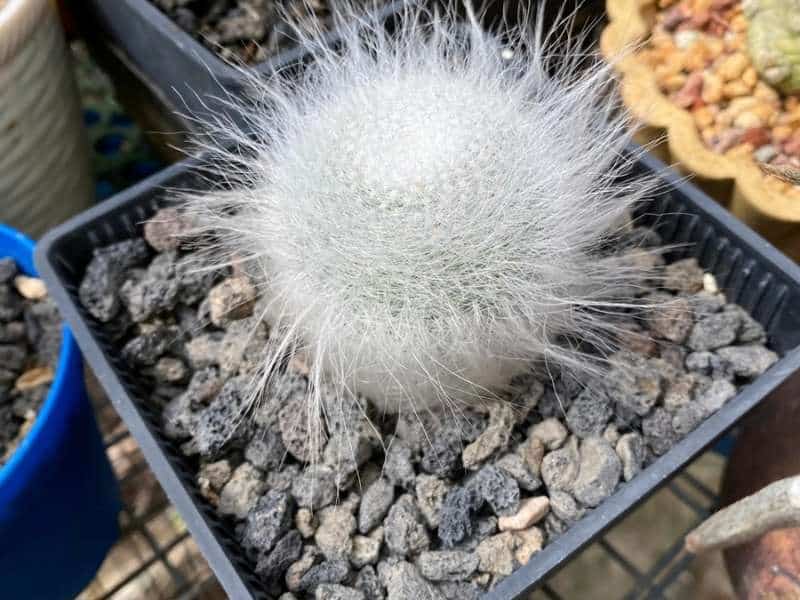
Here are the basic requirements for growing the Peruvian old lady cactus white succulent:
- Indirect sunlight exposure- Preferably the morning sun for 10-12 hours.
- Watering- Should be done after every two weeks in summer and once a month. during winter. Use the deep-watering method to help the roots absorb water quickly.
- Temperatures- It won’t survive in hard frost. Ensure you grow it indoors under grow light.
- Pot it in fast-draining and well-aerated cactus and succulent soil- preferably coarse sand perlite. These types of soil contain between 70% to 80% mineral grit.
- This plant thrives in high humidity conditions. Ensure you put it a room that attracts water particles in the air like near the bathroom or kitchen. Alternatively, you can invest in a good humidifier especially during winter months.
2. Snowflake Cactus
Snowflake, whose scientific name is Euphoria polygona, is another species of cacti. It has dark ribs and spines and it produces dark purple flowers in summer and some parts of spring. This plant is best grown outdoors since it is toxic to humans and animals.

Snowflake cactus prefers the following growing conditions:
- Watering- It needs water after every two weeks in summer, spring and summer. You can water it once a month in winter.
- Temperatures- It prefers Zone 9a temperatures (minimum of 20 degrees Fahrenheit).
- Sunlight- It can survive up to 11 hours of indirect sunlight.
- Soil- The cacti soil (sandy-like) which is fast-draining is the best option for this plant.
3. Lola
Lola, which is a cross-breed of Echeveria lilacina and Echeveria deresina, is an excellent low-maintenance white succulent to grow, making it perfect for gardening newbies.
Since it belongs to the “rosebud” shaped species, you’ll notice that its green leaves have streaks of lavender, pink, and even light blue. During the preceding months of spring, the plant will produce bell-shaped flower stalks.
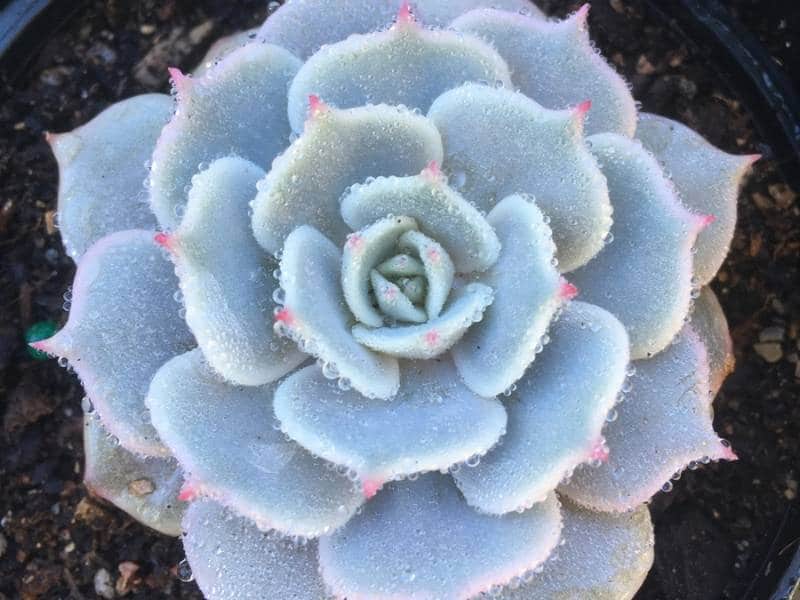
This succulent is native to Mexico and Central America and can grow up to 6 inches tall if you provide it with these conditions:
- Partial sun- Preferably filtered to bright light with sufficient airflow.
- Well-draining soil- It thrives in cacti soil which drains off water fast and promotes sufficient air flow.
- Infrequent watering- It only needs water when the soil is totally dry.
- Temperatures- It needs hardy to zone 9 temperatures (minimum of 20 degrees Fahrenheit).
4. Wooly senecio
The Wooly senecio, whose botanical name is Senecio haworthii, is a succulent stout shrub with a unique texture. Some people prefer to call it Cocoon plant or Ash weed. The plant is native to South Africa and can grow to between 900 and 1200 meters in height.
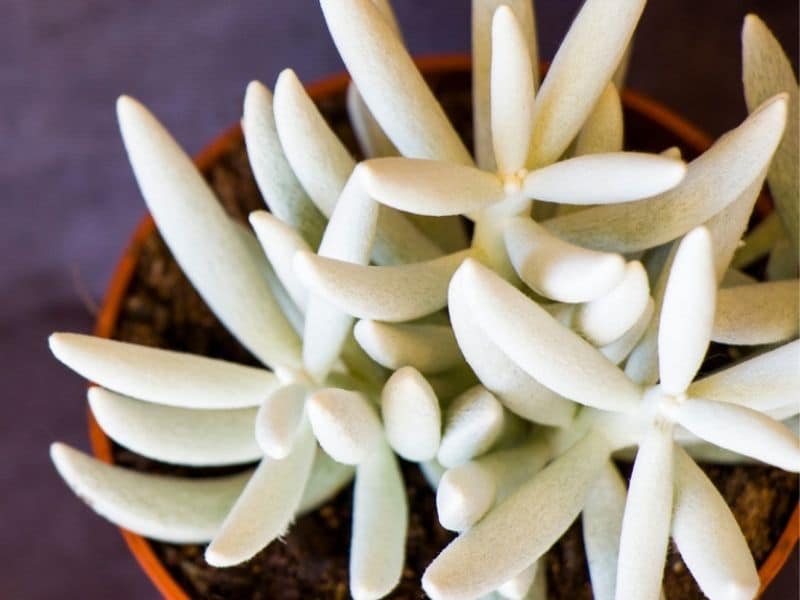
Wooly senecio is a white succulent that produces bright yellow flowers during summer when given favorable growing conditions as summarized below:
- Watering- Prefers fortnightly watering during summer and monthly watering during winter.
- Soil- Grows well in well-draining soil with plenty of grit and sand or cactus soil mix.
- Light- It does best in bright sunlight, preferably in windows.
- Propagation- It works best through its leaves.
5. Tricolor jade
Tricolor Jade is a (Crassula ovata) is a vertical-growing succulent that traces its origins in the rocky slopes of South Africa and Mozambique. It’s a great houseplant that can be potted or grown outdoors as a wild, mounding shrub. It has shiny leaves with streaks of lime green and white.
Some of its leaves turn pink when the sun shines on them.

Give it the following conditions and it will grow up to 8 inches in height:
- Partial sun- It prefers 6 hours of the morning sun.
- Temperatures- Cannot tolerate freezing temperatures of 20 degrees Fahrenheit and below. It’s best to keep it indoors in a well-insulated window during the cold months of winter.
- Watering- Use the pan or sink soaking method to water it. Place the earthenware pot on a pan of water for 10 minutes to allow the bottom soil to sip enough water. Tiny white or black patches on its leaves doesn’t signify root rot. These are pores for transferring water.
- Soil- Preferably cactus sandy soil which drains off water fast and is well-aerated.
6. Brazilian old lady cactus
Did you know that this cactus (Espostoopsis dybowskii) species closely resembles the Peruvian Old Lady Cactus, but is native to Brazil? Like Peruvian cactus, Espostoopsis boasts of long spines that extend past the layer of wooly white hairs.
Since it is one of the rarest species with an unusual appearance, planting it will elevate your novelty. While it hardly reaches maturity in pots, you can still enjoy having it as a houseplant.
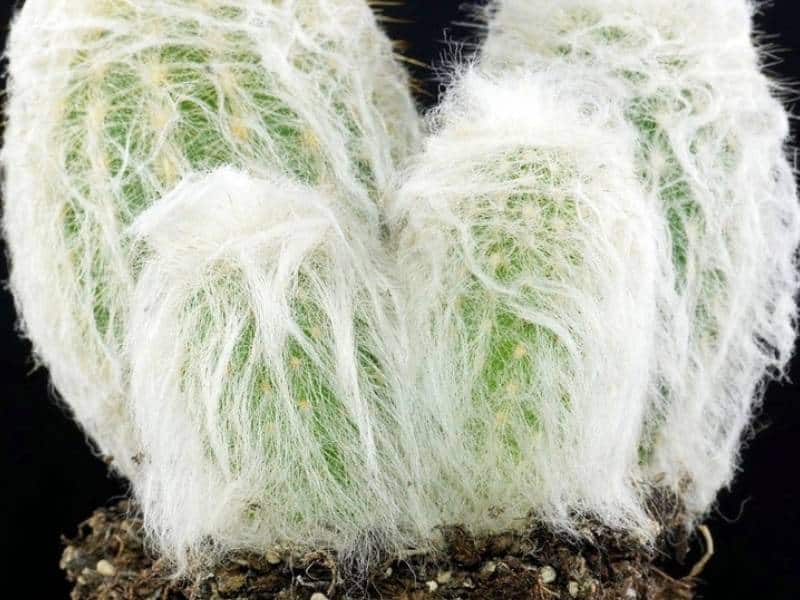
Here are the growing conditions of the Brazilian old lady white cactus:
- Infrequent watering: Water it after three weeks during hot temperatures and after every five to six weeks during cold months.
- Sunlight- It prefers full sun (12 hours indirect exposure to sun).
7. Arizona snowcap
The Arizona Snowcap (Mammillaria gracilis) is a short cactus plant that can grow up to four inches tall at maturity. Its green one-inch stems are covered by a thick layer of white spines.
This plant is drought-resistant, making it a perfect houseplant solution for beginners or people with busy lifestyles. It can grow up to 4 inches tall if well cared for.
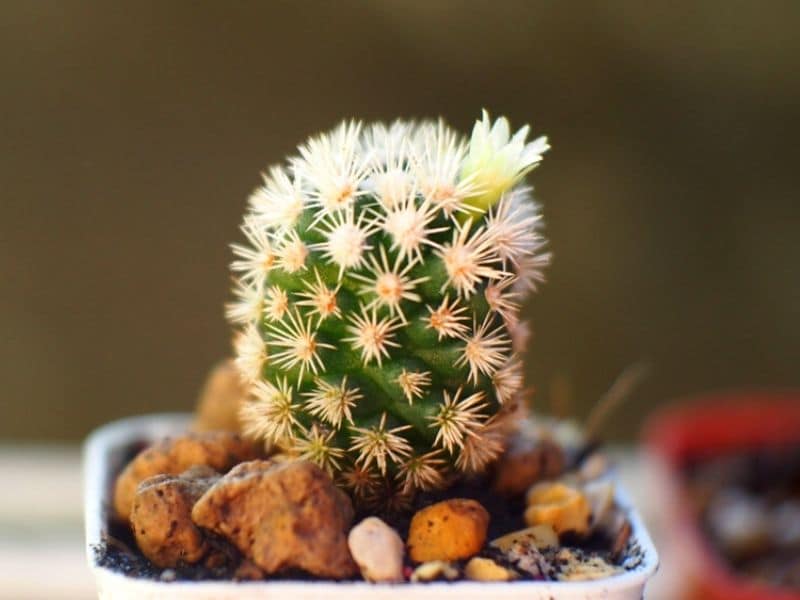
Here are the optimal growing conditions for alphard:
- Infrequent watering- This plant is allergic to prolonged exposure to moisture. Water it after three weeks in summer.
- Soil- Get a well-draining and aerated cactus mix.
- Fertilizer- Should be done during the growing season.
- Temperatures- It prefers hardiness zones 9a to 11b (20-50 degrees Fahrenheit).
- Repot it during the warm season.
8. White ghost

The White Ghost (Euphorbia lactea variegate) is an all-white cactus plant with triangular stems and spine ridges. During summer, it sheds its leaves allowing it to survive in the harshest environments. A mature White Ghost succulent can grow up to 10 feet in height if you provide the following conditions:
- Infrequent watering- This plant is prone to root rot due to overwatering. Water it deeply only when the soil is completely dry.
- Soil- Use cactus potting mix for adequate nourishment.
- Fertilizer- Use less-potent cactus focus fertilizer.
- Light- It prefers very least bright light.
- Humidity- It prefers low humidity but can also survive high room humidity if it isn’t overwatered.
9. White Sprite
Dudleya gnoma, also known as white sprite, is a white succulent with ghostly-like triangular leaves, forming a rosebud-like pattern. Since it is a rare and endemic species, you can grow it as a conservatory plant in a well-draining soil mix.
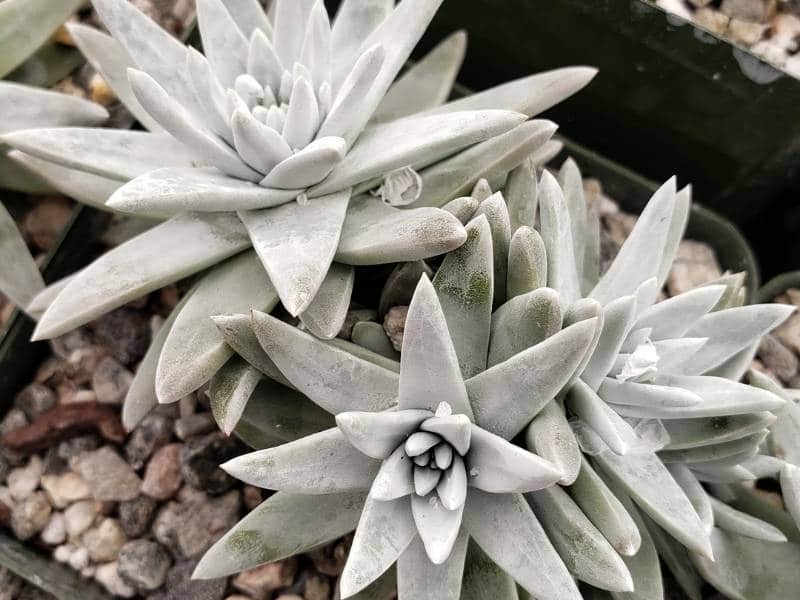
It prefers the following conditions:
- Sun exposure- Prefers full to light sunlight shade (midday shade when summers are hot).
- Temperatures- Prefers zone 9b to 11b temperatures. It can also thrive in moist-cool winters.
- Infrequent watering- Provide water after every three weeks in spring and fall.
- Cultivation and propagation- Grow it as an indoor plant in a fast-draining soil mix or outdoors as a perennial plant.
10. White Ice
Agave titanota, also known as white ice, is a drought-resistant plant that’s native to Mexico. It can grow from one to two inches tall, depending on these conditions:
- Light- Prefers partial to full sun shade.
- Temperatures- Can thrive in temperatures as low as 20 degrees Fahrenheit (zones 9a to 11).
- Potting soil- Use fresh fast-draining soil at re-potting time to provide the plant with nutrients during the first growing season.
11. String of Pearls
The String of Pearls (Senecio rowleyanus) is an unusual-looking succulent whose leaves grow in long strings, like a pendant with pearls. It’s best grown in a hanging basket if you prefer it as a houseplant. Apply the following care tips and watch it put on a multitude of tiny and fuzzy flowers:
- Infrequent watering: Adopt its native environment watering pattern. It prefers a hot and dry environment with little-to-no rainfall. So, the watering should be at least thrice a month.
- Soil- Use gritty soil that drains quickly
What succulent has white flowers?
Succulents and cacti are popularly known for being low-maintenance and unique features. However, one of the most overlooked features is the esthetically appealing flowers they produce. If you’re looking for a succulent with white flowers, check out this list:
- Disc Jade/ Discocactus– Grows only 3 inches tall and 6 inches in width
- Mistletoe Cactu/ Rhipsalis Pilocarpa– Its stems can reach up to 6 feet in length
- Queen of the Night cactus (Selenicereus grandifloras) – Is a one-night bloomer, producing white dramatic flowers.
- Golden Torch/ Echinopsis spachiana– Blooms white flowers anytime from June to July
Are fuzzy succulents poisonous?
Fuzzy succulents are an excellent choice for people who prefer houseplants with esthetic value. However, if you’re a first-time gardening enthusiast, the first thing that may concern you is your safety. Most of the succulents are safe for human health and can provide excellent home remedy solutions. While they may be low-maintenance, plants like Snowflakes and Wooly Senecio can be toxic to humans and pets.
Poisonous fuzzy succulents emit chemicals which when ingested or comes to contact with the skin, may cause mouth, skin or stomach irritations. These plants release these chemicals as a defense mechanism to prevent herbivorous animals from eating them.
Before buying any fuzzy white succulent, ask your provider if it is safe around humans and pets. But if you’ve already bought it, find a hard-to-reach place away from small babies and furry friends.



![Pothos Leaves Curling [Causes + Easy Ways to Fix Leaf Curl]](https://gardenine.com/wp-content/uploads/2020/11/Pothos-leaves-curling.jpg)
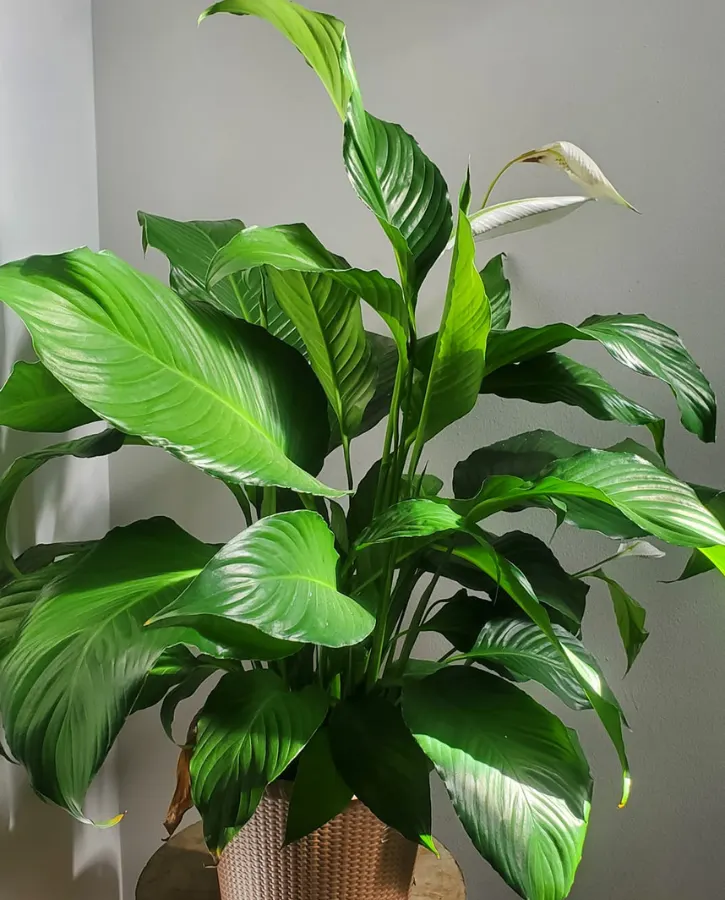
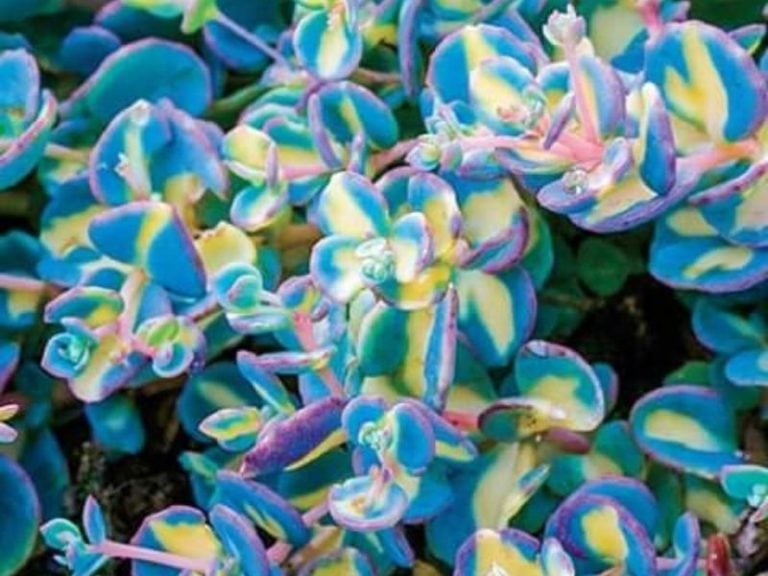

![How to Get Rid of Aphids on Hibiscus [FOR GOOD]](https://gardenine.com/wp-content/uploads/2020/12/Aphids-on-Hibiscus-and-how-to-get-rid-of-them.jpg)